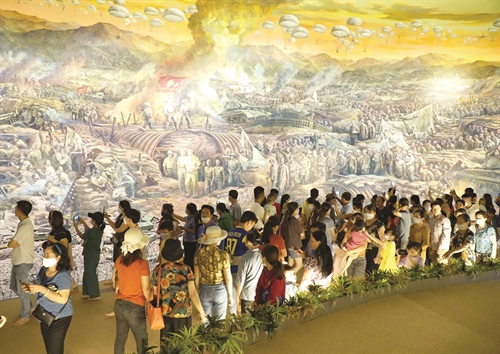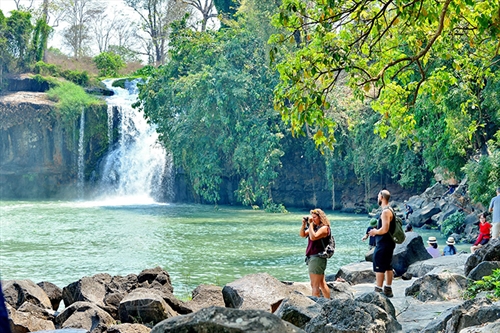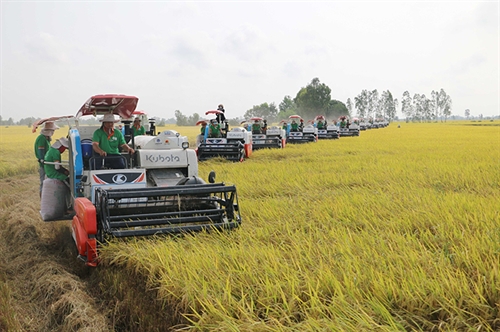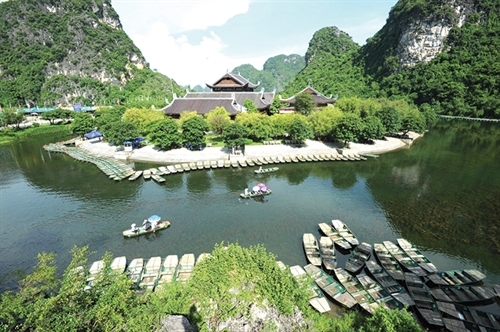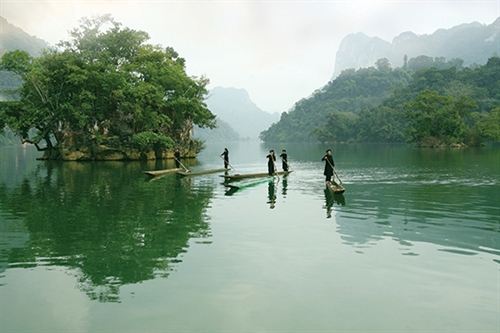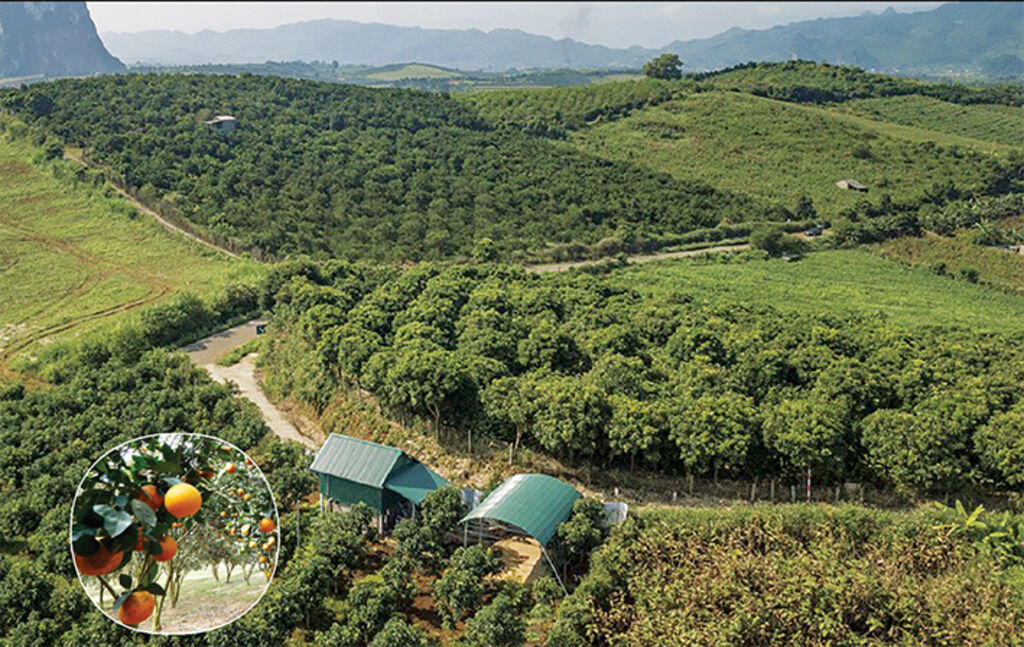 |
| Cao Phong orange gardens in Hoa Binh province__Photo: Trong Dat/VNA |
Hoa Binh province always opens the door wide to foreign investors. It is calling for investment in hi-tech agriculture, processing and manufacturing industries, developing commodity supply and consumption chains, building national tourism sites and destinations and connecting tourism routes, said Secretary of the Hoa Binh Party Committee Nguyen Phi Long.
Located in the northern midland and mountainous region, Hoa Binh province borders Phu Tho province to the north, Hanoi to the east, Son La province to the west and Ninh Binh, Ha Nam and Thanh Hoa provinces to the south.
With a convenient transport network, Hoa Binh province is a gateway connecting northwestern provinces, Red River delta provinces and Hanoi-Hai-Phong-Quang Ninh economic triangle. It is linked with Hanoi and northwestern localities by highway 6, with Thanh Hoa province by highways 12B and 15 and with Nam Dinh province by highway 21A. It is also accessible by Ho Chi Minh Road that runs through Luong Son, Kim Boi, Lac Thuy and Yen Thuy districts. The province is now speeding up the construction of the 32.5 km road connecting it and Hanoi capital, the 20.2 km section from it to Moc Chau district of neighboring Son La province and the Hoa Lac-Hoa Binh expressway. Thanks to the Hoa Lac-Hoa Binh expressway that was opened to traffic in October 2018, the travelling time from Hanoi to the province has been shortened to less than an hour.
The province is now taking advantage of its tropical monsoon climate and geographical conditions to develop efficient and sustainable agriculture. It has successfully maintained the growing and breeding areas of its advantageous farm produce such as Cao Phong orange, Tan Lac pomelo, Da river fish and Lac Son chicken. Hoa Binh is also striving to turn its industry into an impetus of its economy to propel the development of services and agriculture. It has received the Prime Minister’s green light to set up new industrial parks covering a total of 1,260 hectares and 21 cottage industry clusters covering a total of more than 800 hectares.
At present, the province houses 37 foreign direct investment (FDI) projects that are worth a total of around USD 608 million. With 19 projects capitalized at USD 182 million, the Republic of Korea is leading the total of seven countries and territories investing in the province. It is followed by Japan with 10 projects and China with three projects. Five other projects are invested by Indonesia, India, Singapore and Chinese Taipei.
With the determination to lure investors for Hoa Binh’s development, its authorities have rolled out special investment incentives in corporate income tax and land rental for new investment projects in hi-tech agriculture, processing industry and manufacturing of farm produce.
Investment projects in the sectors and trades eligible for investment incentives that are implemented in areas meeting with difficult socio-economic conditions will enjoy similar investment incentives offered to investment projects implemented in areas meeting with extremely difficult socio-economic conditions.
Specifically, the corporate income tax rate of 10 percent for 15 years will be applicable to new investment projects manufacturing products on the list of products of support industries prioritized for development which satisfy either of the following criteria:
- They are products of support industries for high technologies specified in the Law on High Technology;
- They are products of support industries for production of products of textile and garment; leather and footwear; electronics and informatics; automobile manufacture and assembly; and mechanical engineering, which cannot be produced at home by January 1, 2015, or can be produced at home but must satisfy the European Union technical standards or the equivalent.
Meanwhile, incomes earned by cultivation, animal husbandry or processing enterprises in the field of agriculture or fisheries not in areas with difficult socio-economic conditions or extremely difficult socio-economic conditions will be entitled to the corporate income tax rate of 15 percent throughout their operation periods.
The corporate income tax rate of 20 percent for 10 years will be applied to new investment projects manufacturing hi-quality steel, energy-saving products, machinery and equipment for agricultural production, forestry, fisheries or salt production, irrigation and drainage equipment; producing or processing cattle, poultry or aquatic animal feeds; or developing traditional crafts or trades.
In addition, investment projects in the fields eligible special investment incentives and located in areas meeting with extremely difficult socio-economic conditions will be exempted from land rental for their entire lease periods.
According to Long, the province is focusing on not only economic development but also the preservation and upholding of the Muong culture and “Hoa Binh culture” to attract more tourists. It is luring investors to Kim Boi hot spring tourism site, Mai Chau district’s Lac village and Cao Phong district’s Giang Mo village cultural tourism sites, Ngoc Son-Ngo Luong, Phu Canh and Hang Kia-Pa Co nature reserves and Hoa Binh reservoir national tourism site.
The province boasts potential and advantages for the development of ecotourism, wellness and cultural and spiritual tourism. It has 786 intangible cultural heritages including social practices and beliefs, traditional festivals, traditional crafts and folklore knowledge and more than 18,000 valuable artifacts depicting “Hoa Binh culture”. Worthy of note are four national intangible cultural heritages of Muong people: Mo Muong - the Muong folk encyclopedia that has been orally handed down through many generations; gong arts; bamboo calendar and Long Tong festival. The 28.8 percent year-on-year rise in the number of tourists in the first half of this year was attributed to the sector’s constant efforts. The sector has promoted the province’s image at the northwest quintessence festival in Ho Chi Minh City, the expanded northwest tourism-culture week in Can Tho city and the northwest tourism fair 2023 in Phu Tho city under a program on tourism development cooperation among eight Vietnamese northwestern provinces.
The province expects to welcome 3.5 million tourists, including 150,000 foreign vacationers, and rake in VND 3.9 trillion (USD 162.5 million) this years.- (VLLF)
